
Edition 3 (2020)
Jan Ehrenwert, James Eisenkraft, James Berry
Offering highly visual, easy-to-read coverage of the full range of anesthesia equipment in use today, this authoritative reference is your go-to text for objective, informed answers to ensure optimal patient safety. Anesthesia Equipment, 3rd Edition, provides detailed information on the intricate workings of each device or workstation, keeping you fully up to date and helping you meet both equipment and patient care challenges.
Remains unequalled in both depth and breadth of coverage, offering readable, concise guidance on all aspects of today’s anesthesia machines and equipment.
Details the latest machines, vaporizers, ventilators, breathing systems, vigilance, ergonomics, and simulation.
Improves your understanding of the physical principles of equipment, the rationale for its use, delivery systems for inhalational anesthesia, systems monitoring, hazards and safety features, maintenance and quality assurance, special situations/equipment for non-routine adult anesthesia, and future directions for the field.
Includes ASA Practice Parameters for care, and helps you ensure patient safety with detailed advice on risk management and medicolegal implications of equipment use.
Highlights the text with hundreds of full-color line drawings and photographs, graphs, and charts.
Enhanced eBook version included with purchase. Your enhanced eBook allows you to access all of the text, figures, and references from the book on a variety of devices.
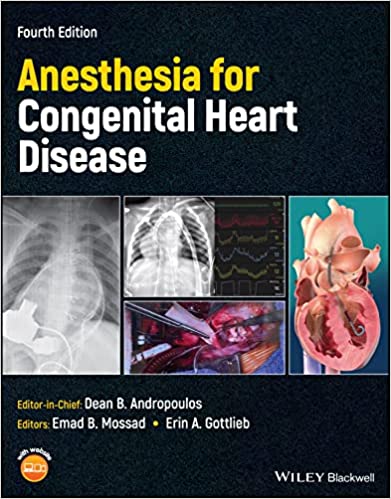
Edition 4 (2023)
Dean Andropoulos, Emad Mossad, Erin Gottlieb
An Extensive Reference Work Detailing the Procedures, Knowledge, and Approaches in Anesthesia for Congenital Heart Disease
In the 4th edition of Anesthesia for Congenital Heart Disease, a distinguished group of expert authors in congenital heart disease from all over the world provide a thorough, comprehensive and fully updated overview of the specifics of congenital heart disease (CHD), and the intricacies involved with administering anesthetic care to patients who suffer from the myriad of lesions encompassed by CHD.
In the seven years since the 3rd Edition of Anesthesia for Congenital Heart Disease was published, an explosion of new procedures, approaches, and patients eligible for anesthetic care has occurred. The goal of Anesthesia for Congenital Heart Disease, Fourth Edition is to help readers understand all of the recent advancements and developments in the field while also imparting a foundation of essential historical knowledge. The book contains new chapters that reflect exciting new approaches in this rapidly changing field, and also includes:
Updated information in the chapter Adult Congenital Heart Disease and Mechanical Support of the Circulation, reflecting the increasing prominence of these patients in CHD care
New chapters on Informatics and Artificial Intelligence, Genetic Syndromes, Point of Care Ultrasound, and Cardiopulmonary Resuscitation in Congenital Heart Disease
Thorough updates of all chapters with many new figures and tables, and hundreds of new recent references provide up to date information
Anesthesia for Congenital Heart Disease, Fourth Edition serves as a thorough and in-depth reference work and is an essential resource for practitioners providing perioperative care to CHD patients.

Edition 6 (2019)
Richard Jaffe, Clifford Schmiesing, Brenda Golianu
Covering both surgical and anesthetic considerations, Anesthesiologist’s Manual of Surgical Procedures, Sixth Edition, is an essential resource for formulation of an anesthetic plan and perioperative management of patients. All chapters are written by both surgeons and anesthesiologists, giving you a detailed, real-world perspective on the many variables that accompany today’s surgical procedures.
Presents preoperative, intraoperative, and postoperative anesthetic considerations in a clear, templated format, summarizing all courses of action in easy-to-read tables.
Describes what the surgeon will likely be doing, variants of the procedure or approaches, patient population characteristics, and details of the procedure including positioning, length of procedure, postop care, and more.
Features a full-color design to enhance readability of the tables and clarity of the illustrations.
Updates to this edition include a new, heavily illustrated chapter overviewing regional blocks and new appendices covering individual components of enhanced recovery (ERAS) protocols and intraoperative use of transnasal humidified rapid-insufflation ventilatory exchange (THRIVE); as well as new, rapidly accessible tables and figures set on the inside back cover reviewing useful, but easily forgotten facts and dermatomes.
An ideal reference for anesthesiologists, anesthesia residents, and CRNAs.

Edition 3 (2017)
David Longnecker, Mark Newman, Warren Zapol, Warren Sandberg, Sean Mackey
The gold-standard text in anesthesiology – from the field’s brightest, most respected minds
Written by an internationally known team of experts, Anesthesiology, Third Edition provides a 360-degree view of the field, covering all the anesthetic considerations from preoperative preparation through postoperative care, and the full breadth of anesthesia practice, including pain medicine and critical care medicine. Presented in full color and updated to capture the latest breakthroughs and advances, Anesthesiology is designed to provide the practitioner with an authoritative single-source reference that spans the full spectrum of anesthesia practice.
Much more than a how-to manual of anesthetic techniques, Anesthesiology, Third Edition presents an accessible compilation of concepts and principles that affirms its status as the cornerstone text in anesthesiology. This edition emphasizes important trends in both the specialty and healthcare in general. These trends include team-based anesthesia care, the remarkable growth of pain medicine practice, and the expanded need for clinicians who are skilled in the practice of critical care medicine.
Features:
• Four new pain medicine chapters, plus an expanded section on anesthetic considerations and perioperative management of co-existing disease
• Key Points and Key References encapsulate must-know information and guide you to important articles for further research
• Balanced presentations present clinical information, practical clinical procedures, and the molecular and scientific foundations of anesthesia practice
• Essential for residents and students preparing for initial certification, and for practitioners preparing for recertification
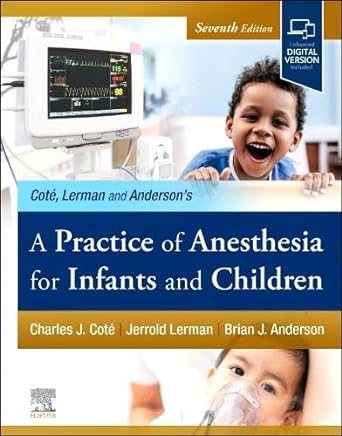
Edition 7 (2024)
Charles Cote, Jerrold Lerman, Brian Anderson
Covering everything from preoperative evaluation to neonatal emergencies to the PACU, Coté, Lerman and Anderson’s A Practice of Anesthesia in Infants and Children, 7th Edition, features state-of-the-art advice on the safe, effective administration of general and regional anesthesia and sedation strategies for young patients. This text reviews underlying scientific information, addresses preoperative assessment and anesthesia management in detail, and provides guidelines for postoperative care, emergencies, and special procedures. Comprehensive in scope and thoroughly up to date, this edition delivers unsurpassed coverage of every key aspect of pediatric anesthesia.
Presents must-know information on standards, techniques, and the latest advances in pediatric anesthesia from global experts in the field.
Contains thoroughly updated content throughout, with new contributors to lend a fresh perspective, updated figures and tables, and the latest information on perioperative fluid management, pharmacology, interventional devices, resuscitation, and more.
Covers key topics such as anesthetizing children with cancer, neonatal and pediatric emergencies, the obese child and bariatric surgery, interventional devices for children with congenital heart defects, cardiopulmonary resuscitation, simulation in pediatric anesthesia, patient safety and quality assurance, and more.
Features an extensive video library of pediatric anesthesia procedures, particularly difficult airway management strategies, new positioning devices, cardiac assist devices in action, management of burn injuries, how to perform ultrasound-guided regional anesthesia blocks and techniques, and much more.
Essentials chapters provide focused input from expert subspecialty pediatricians who share the latest information concerning hematology, pulmonology, oncology, hepatology, nephrology, and neurology.
Includes a laminated pocket reference guide with essential, practical information, and key references at the end of each chapter that provide a quick summary for review. An extended online version is available in the app (“Pedi Anesth”; Starship Children’s Hospital, Auckland District Health Board, NZ).
An eBook version is included with purchase. The eBook allows you to access all of the text, figures, and references, with the ability to search, customize your content, make notes and highlights, and have content read aloud. Any additional digital ancillary content may publish up to 6 weeks following the publication date.
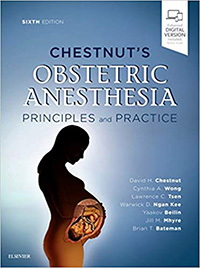
Edition 5 (2019)
David Chestnut, Cynthia Wong, Lawrence Tsen, Warwick Ngan Kee, Yaakov Beilin, Jill Mhyre, Brian Bateman, Naveen Nathan
Comprehensive, user-friendly, and up to date, Chestnut's Obstetric Anesthesia: Principles and Practice, 6th Edition, provides the authoritative clinical information you need to provide optimal care to your patients. This substantially revised edition keeps you current on everything from basic science to anesthesia techniques to complications, including coverage of new research that is paving the way for improved patient outcomes. An expert editorial team ensures that this edition remains a must-have resource for obstetric anesthesiologists and obstetricians, nurse anesthetists and anesthesiology assistants, and anesthesiology and obstetric residents and students.
Presents the latest information on anesthesia techniques for labor and delivery and medical disorders that occur during pregnancy, emphasizing the treatment of the fetus and the mother as separate patients with distinct needs.
Contains new chapters on shared decision-making in obstetric anesthesia and chronic pain during and after pregnancy.
Features extensive revisions from cover to cover, including consolidated information on maternal infection and postoperative analgesia.
Covers key topics such as neonatal assessment and resuscitation, pharmacology during pregnancy and lactation, use of nitrous oxide for labor analgesia, programmed intermittent epidural bolus (PIEB) technique, epidural analgesia-associated fever, the role of gastric ultrasonography to assess the risk of aspiration, sugammadex in obstetric anesthesia, the role of video laryngoscopy and new supraglottic airway devices, spinal dysraphism, and cardiac arrest in obstetric patients.
Incorporates the latest guidelines on congenital heart disease and the management of sepsis, as well as difficult airway guidelines that are specific to obstetric anesthesia practice.
Offers abundant figures, tables, and boxes that illustrate the step-by-step management of a full range of clinical scenarios.
Enhanced eBook version included with purchase. Your enhanced eBook allows you to access all of the text, figures, and references from the book on a variety of devices.

Edition 9 (2023)
Bruce Cullen, M. Christine Stock, Rafael Ortega, Sam Sharar, Natalie Holt, Christopher Connor, Naveen Nathan
Covering the full spectrum of clinical issues and options in anesthesiology, Barash, Cullen, and Stoelting’s Clinical Anesthesia, Ninth Edition, edited by Drs. Bruce F. Cullen, M. Christine Stock, Rafael Ortega, Sam R. Sharar, Natalie F. Holt, Christopher W. Connor, and Naveen Nathan, provides insightful coverage of pharmacology, physiology, co-existing diseases, and surgical procedures. This award-winning text delivers state-of-the-art content unparalleled in clarity and depth of coverage, as well robust multimedia features that equip you to effectively apply today’s standards of care and make optimal clinical decisions on behalf of your patients.
Comprehensively covers the entire field of anesthesiology with a practical, clinical focus throughout
Features extensive multimedia content, including more than 300 updated procedural videos and 190 narrated interactive clinical vignettes
Includes Key Points in every chapter, with corresponding numbers in the chapter margins for quick reference
Highlights key references to quickly direct you to the most important and high-yield further reading
Contains useful appendices with formulas, pacemaker and implantable cardiac defibrillator protocols, information on herbal medications, an atlas of echocardiography, and more.

Edition 1 (2021)
Edmond Cohen
Ideal for clinicians at all levels of experience―from the resident to the subspecialist―Cohen’s Comprehensive Thoracic Anesthesia compiles the many recent advances in thoracic anesthesiology into one convenient, easy-to-use reference. Concise, clinically focused chapters written by international authorities in the field cover all facets of anesthesia practice for thoracic procedures, logically organized by preoperative, intraoperative, and postoperative considerations.
Discusses new devices for lung isolation, new lung protection protocols, new information on post-operative complications, and new drugs for modulating pulmonary circulation.
Covers 20 key procedures including tracheal resection, esophagectomy, mediastinoscopy, mediastinal mass, SVC syndrome, and more.
Describes complex surgeries related to the lungs, pleura, diaphragm, and esophagus.
Provides case studies and clinical vignettes to illustrate and support case management decisions.
Offers highly practical guidance for quick reference from editor Dr. Edmond Cohen and a team of expert contributing authors from around the world.
Features extensive illustrations throughout, including clinical photos and drawings, radiographic images, device images, charts, and graphs.
Enhanced eBook version included with purchase. Your enhanced eBook allows you to access all of the text, figures, and references from the book on a variety of devices.
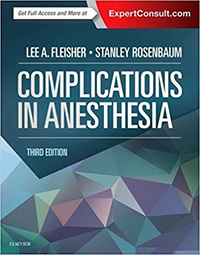
Edition 3 (2017)
Lee Fleisher, Stanley Rosenbaum
Using a unique, problem-solving approach, Complications in Anesthesia, 3rd Edition, walks you through effective solutions to common complications in anesthesia and critical care. This practical reference uses a highly structured, clearly illustrated format to bring you up to date with what’s new in the field, help you anticipate potential challenges, and guide you through life-saving solutions.
Presents content in an updated, logical organization covering various types of complications (drugs, testing, intubation, line insertion, surgical procedures, etc.) followed by differential diagnosis and treatment of signs of complications (intraoperative, such as hypoxia or hypotension; and postoperative, such as MI).
Follows a problem-based, practice-oriented approach throughout; case synopses are followed by concise coverage of recognition, risk assessment, implications, management, and prevention.
Allows you to review the case reports, contemplate the implications, then check your response against what the experts have to say.
Includes numerous photographs, diagrams, flow charts, and tables that illustrate key concepts.
Ideal as a clinical reference and as a study tool when preparing for oral boards.
Brings you up to date with new safety standards and the latest ASA guidelines.
Expert Consult™ eBook version included with purchase. This enhanced eBook experience allows you to search all of the text, figures, and references from the book on a variety of devices.
Edition 1 (2018)
A. Agatha Crear-Gilbert, Mark MacGregor
Part of the popular Core Topics series, this book provides a practical guide to pre-operative assessment for consultants and trainee anaesthetists. Chapters cover comprehensive evidence-based guidance for assessing and managing patients with particular conditions, as well as perioperative risk stratification and challenges of pre-assessment. The chapters have been written by specialists in the respective clinical fields, while all content has been edited by anaesthetists to assure it is relevant and accessible to the anaesthetist in the everyday pre-operative clinic. Written specifically for anaesthetists, this resource will allow every reader to contribute effectively in a multidisciplinary approach when assessing and risk stratifying patients to ensure that they are optimised before surgery.
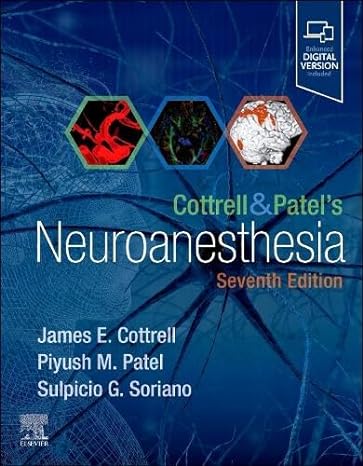
Edition 7 (2024)
James Cottrell, Piyush Patel
Balancing must-know scientific knowledge with clinical applications, Cottrell and Patel's Neuroanesthesia, 7th Edition, reflects the latest developments in neurosurgical anesthesia, providing a comprehensive, authoritative overview of this challenging field. Clinically oriented chapters offer key clinical points, case presentations, and discussions, delivering the complete and authoritative guidance you need to ensure optimal perioperative care and safety for neurosurgical patients. Broad, clearly organized coverage of all important aspects of neuroanesthesia enables you to find reliable answers to any clinical question.
Integrates current scientific principles with the newest clinical applications, including current clinical management guidelines for neurosurgical patients.
Provides expert guidance on what to do under a variety of circumstances, the logic behind why it should be done, and tips for avoiding complications.
Includes clear, conceptual illustrations throughout, along with neuroimaging, clinical photos, charts and graphs, and clinical algorithms, making complex concepts easier to understand at a glance.
Covers the latest advancements in the field including cerebrospinal fluid hemodynamics and physiology, minimally invasive techniques, brain tissue oxygenation oximetry, microdialysis, neuroimaging and neurointerventional radiology, traumatic brain injury, pediatric neuroanesthesia, and acute treatment of depression.
An eBook version is included with purchase. The eBook allows you to access all of the text, figures, and references, with the ability to search, customize your content, make notes and highlights, and have content read aloud. Any additional digital ancillary content may publish up to 6 weeks following the publication date.

Edition 6 (2020)
George Gregory, Dean Andropoulos
As the field pediatric anesthesia advances and expands, so too does the gamut of challenges that are faced by today’s anesthesiologists. Gregory’s Pediatric Anesthesia aims to fully prepare trainees and experienced professionals for modern practice by equipping them with the knowledge and cutting-edge techniques necessary to safely and successfully anesthetize children for a range of different surgeries and other procedures. Supporting their work with current data and evidence, the authors explore topics including basic principles, potential complications, and best practice, and illustrate their findings with detailed case studies that cover all major subspecialties.
This essential new edition includes access to illustrative videos and features new and expanded sections, such as:
Anesthesia for Spinal Surgery complications including postoperative blindness
Robotic surgery for Pediatric Urological Procedures
Anesthesia for Non-Cardiac Surgery in Patients with Congenital Heart Disease (new chapter)
Extensive additional ultrasound images for regional anesthesia
Neonatal Resuscitation
The Pediatric Surgical Home and Enhanced Recovery after Surgery (new chapter)
Now in its sixth edition, Gregory’s Pediatric Anesthesia continues to provide reliable and easy-to-follow guidance to all anesthesiologists caring for younger patients.
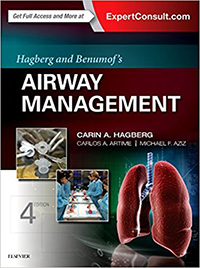
Edition 4 (2017)
Carin Hagberg
Anesthesiologists, residents, and advanced practice practitioners alike rely upon the comprehensive content of Hagberg and Benumof’s Airway Management to remain proficient in this essential area. The 4th Edition, by Drs. Carin A. Hagberg, Carlos A. Artime, and Michael F. Aziz, continues the tradition of excellence with coverage of new devices and algorithms, new research, new outcomes reporting, and much more – while retaining a concise, how-to approach; carefully chosen illustrations; and case examples and analysis throughout.
Offers expert, full-color guidance on pre- and post-intubation techniques and protocols, from equipment selection through management of complications.
Includes access to more than 25 videos online, including ultrasonography and non-invasive airway management and flexible scope intubation.
Includes the latest ASA guidelines, as well as six all-new chapters including airway management in nonoperating room locations (NORA), airway management and outcomes reporting, and more.
Features completely rewritten chapters on airway pharmacology, algorithms for management of the difficult airway, airway assessment, video-assisted laryngoscopy, and many more.
Reviews new airway devices and techniques, along with indications for and confirmation of tracheal intubation.
Brings you up to date with the latest devices, the DAS extubation algorithm, the Vortex approach, and emergency cricothyrotomy.
Expert Consult™ eBook version included with purchase. This enhanced eBook experience allows you to search all of the text, figures, and references from the book on a variety of devices.

Edition 8 (2024)
Joel Kaplan
Current, comprehensive, and evidence-based, Kaplan's Cardiac Anesthesia: Perioperative and Critical Care Management, 8th Edition, offers practical guidance from today’s international leaders in cardiac anesthesiology, helping you to optimize perioperative outcomes, avoid complications, and ensure maximum patient safety. Dr. Joel A. Kaplan, along with an expert team of associate editors, guides you through today’s clinical challenges, including expanded coverage of critical care, the newest approaches to perioperative assessment and management, state-of-the art diagnostic techniques, and cardiovascular and coronary physiology.
Covers the full spectrum of contemporary cardiothoracic anesthesia practice, including preoperative assessment, physiology, pharmacology, monitoring, transesophageal echocardiography, coagulation, specific cardiac procedures, extracorporeal circulation, postoperative pain treatment, and management of the complex patient with cardiac disease.
Includes expanded coverage of critical care topics, reflecting the increased perioperative care now provided by anesthesiologists in the ICU.
Contains new chapters on Structural Heart Disease Procedures; Cardiorespiratory Effects of COVID-19; Critical Care Ultrasound; Intensive Unit Management of Patients on Mechanical Circulatory Support; and Postoperative Care of the Heart and Lung Transplant Patient.
Features more than 900 full-color illustrations, decision trees, charts, and graphs (over one-third are new) that aid in visual understanding of complex topics.
Provides access to over 120 videos, including a range of echocardiography clips.
Contains balanced, dependable, and updated content on all aspects of the anesthetic management of cardiac surgical procedures, as well as cardiology procedures performed in catheterization and electrophysiologic laboratories.
Places new emphasis on cardiac devices requiring perioperative care, including cardiac implanted electrical devices and ventricular assist devices.
An eBook version is included with purchase. The eBook allows you to access all of the text, figures and references, with the ability to search, customize your content, make notes and highlights, and have content read aloud.

Edition 1 (2015)
William Rosenblatt, Wanda Popescu
Overcome the toughest airway challenges with Master Techniques in Upper and Lower Airway Management! Under the preeminent editorial guidance of William Rosenblatt, MD and Wanda Popescu, MD, a multitude of expert anesthesiologists guide you through all the ins and outs of managing difficult airways. This anesthesiology reference’s case-based approach demonstrates the clinical applications of important principles, and a large collection of online videos shows you how to perform key techniques successfully.
“Two master clinician educators, Drs. William Rosenblatt and Wanda Popescu, calling on their expertise in airway management and thoracic anesthesia, respectively, have developed a unique book which explores the pathway of the airway from lips (nares) to the terminal bronchi to develop a highly focused volume with accompanying e-media to highlight clinical management. Although the organization of the book may seem obvious or intuitive, this is the first time a textbook has been developed in this manner. For the reader, these individuals have assembled the ‘go to faculty’ for both pre-operative consultation, as well as, intra-operative airway related events in their specialties.”
– from the Foreword by Paul G. Barash MD
Key Features:
Be prepared to tackle a complete range of upper airway problems with comprehensive coverage of everything from evaluation and basic management of the difficult upper airway patient, through pre-existing conditions • otolaryngology and maxillofacial procedures • nasal intubation, tracheostomy, and foreign bodies • pediatric patients • the at-risk cervical spine • extubation, and more, as well as lower airway issues including interventional pulmonology • lung isolation devices and techniques • airway surgery • surgeries requiring lung isolation • congenital abnormalities of the lower airway • lung transplantation • lower airway emergencies • and more.
Apply principles in practice by reviewing case histories that show concrete applications in the context of managing real patients. Then challenge your decision making with case-based questions and answers that delve into the details that lead to optimal outcomes.
Master vital nuances of technique by watching a large collection of online videos derived from more than 700 actual patients.
Now with the print edition, enjoy the bundled interactive eBook edition, offering tablet, smartphone, or online access to:
Complete content with enhanced navigation
A powerful search that pulls results from content in the book, your notes, and even the web
Cross-linked pages, references, and more for easy navigation
Highlighting tool for easier reference of key content throughout the text
Ability to take and share notes with friends and colleagues
Quick reference tabbing to save your favorite content for future use
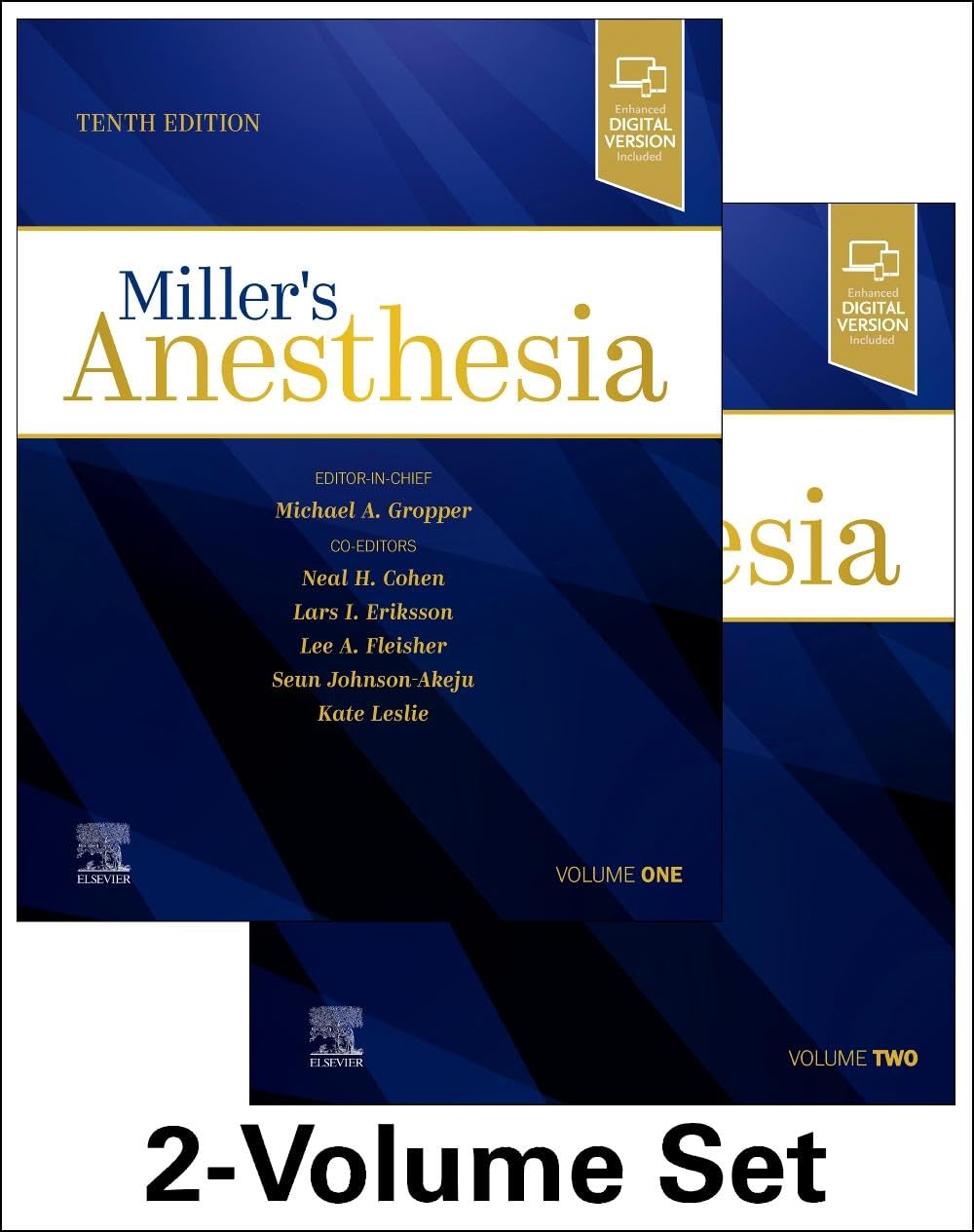
Edition 10 (2024)
Michael Gropper, Neal Cohen, Lars Eriksson, Lee Fleisher, Seun Johnson-Akeju, Kate Leslie
Offering up-to-date coverage of everything from historical and international perspectives to basic science and today’s clinical practice, Miller's Anesthesia, 10th Edition, remains the #1 reference and trusted learning resource for practitioners and trainees in this complex field. Dr. Michael Gropper leads a team of expert editors and contributing authors who provide current information on the technical, scientific, and clinical issues you face each day―whether you’re managing a challenging patient care situation, preparing for the boards, or studying for recertification.
Addresses timely topics alongside foundational basic science for an in-depth and comprehensive understanding of the field.
Contains thoroughly up-to-date content, including two new chapters: The Immune System: Implications for Anesthetic Management and Emergency Preparedness in Healthcare.
Provides new content in key areas such as sustainability, global health equity, the effect of anesthetics on immune function, anesthesia for special populations, coverage of infectious diseases including COVID-19, and occupational exposure and safety.
Offers state-of-the-art coverage of anesthetic drugs, guidelines for anesthetic practice and patient safety, new techniques, step-by-step instructions for patient management, the unique needs of pediatric patients, and much more―all highlighted by more than 1,200 full-color illustrations (300 new to this edition) for enhanced visual clarity.
Includes 40+ video clips demonstrating patient positioning, ultrasound, echocardiograms, and other imaging, and anesthetic procedures in real time.
An eBook version is included with purchase. The eBook allows you to access all of the text, figures and references, with the ability to search, customize your content, make notes and highlights, and have content read aloud. Additional digital ancillary content may publish up to 6 weeks following the publication date.
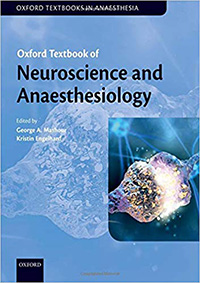
Edition 1 (2019)
George Mashour, Kristin Engelhard
The perioperative care of individuals with neurologic compromise is critically important, yet it is only one dimension of the rich relationship between anaesthesiology and the neurosciences. The mechanism of everyday therapeutic interventions such as anaesthesia and analgesia is exciting neuroscience in its own right. At the new frontier of outcomes studies lies the question of how the perioperative period might impact the brain. For example, questions related to anaesthetic neurotoxicity, delirium, and cognitive dysfunction pose critical challenges for the field.
The Oxford Textbook in Neuroscience and Anaesthesiology addresses the exciting field of neuroanaesthesiology in a new and stimulating way. In twenty eight chapters, the neuroscientific basis of anaesthesiology, the full spectrum of clinical neuroanaesthesia, and the care of neurologic patients undergoing non-neurologic surgery are explored in one comprehensive textbook for the first time.
The first section considers the neural mechanisms of general anaesthetics, cerebral physiology, the neurobiology of pain, and more. The second section explores the care of patients with neurologic disease in the operating room or intensive care unit. These clinical chapters systematically treat the perioperative considerations of both brain and spine surgery, and provide introductions to neurocritical care and pediatric neuroanaesthesia. The final section outlines the care of neurologic patients undergoing non-neurologic surgery. It examines key connections of neurology and anaesthesiology, examining how conditions such as dementia, stroke, or epilepsy interface with the perioperative period.
Each chapter has been carefully crafted to be concise yet highly informative, reflecting the cutting edge of neuroscience and neuroanaesthesiology. This international textbook gathers the best available expertise of authors and leaders worldwide. Includes access to online-only content, including more than 20 cases and more than 90 questions that can be used in presentations and teaching sessions. By activating your unique access code, you can access and use the material.
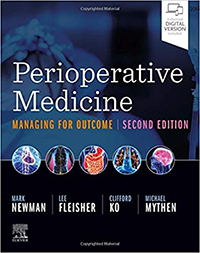
Edition 2 (2021)
Mark Newman, Lee Fleisher, Clifford Ko, Michael Mythen
Based on the most current evidence and best practices, Perioperative Medicine: Managing for Outcome, 2nd Edition, is an easy-to-follow, authoritative guide to achieving optimal outcomes in perioperative care. Written and edited by recognized authorities in anesthesiology and surgical critical care, this fully updated edition helps you think critically about complex, long-term issues surrounding the care of the surgical patient, providing decision trees that define strategies to enhance the medical outcome of care.
Focuses on what anesthesiologists, surgeons, and intensivists need to know in order to improve outcomes through evidence- and outcome-based approaches.
Provides practical guidance on potential risks to all major organ systems, the etiology of particular organ dysfunctions, preoperative and intraoperative risk factors, and perioperative protection strategies to minimize potential complications.
Features a consistent chapter format - with even more color-coded algorithms, summary tables, and boxes – that enables you to quickly explore and determine the best management approaches.
Includes six all-new chapters: Perioperative Fluid Management; Delirium and POCD; Role of Palliative Care/ICU; Value-Based Care: The UK Model; CFO Perspective on Value; Hospital to Home (Perioperative Transitions of Care)
Discusses timely topics such as quality improvement, pay-for-performance, preexisting disease and comorbid conditions in anesthesiology, and the team-based model of care.
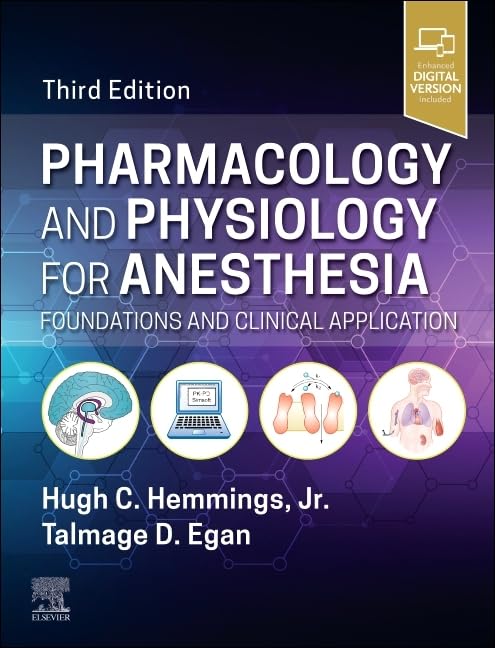
Edition 3 (2026)
Hugh Hemmings, Talmage Egan
An ideal resource for study, review, and successful anesthesiology practice, Pharmacology and Physiology for Anesthesia, 3rd Edition, provides the foundational information in pharmacology, physiology, and molecular-cellular biology to staycurrent with contemporary practice. This fully updated edition is invaluable for anesthetists and intensivists in perioperative patient management, offering a one-stop, detailed overview of the physiological and pharmacological principles underlying anesthesia―including clinical applications―helping you make informed decisions on anesthetic drug selection and administration, physiological management, and treatment of common disease in the perioperative period.
Covers the normal and pathologic physiology affected by anesthetic interventions in surgical and critical care environments, including comprehensive information on anesthesia- related pharmacology such as drug mechanisms, pharmacokinetics, pharmacodynamics, pharmacogenetics, and pharmaceutical chemistry
Reflects recent advances in the field such as new coagulation therapies, target controlled infusion (TCI) technology, pharmacogenomics, and glucagon-like-peptide-1 (GLP-1) agonists and their implications for anesthesia practice
Includes significantly expanded chapters on blood management and hemostasis, and the pharmacology of intravenous anesthetics, antihypertensive agents, and anti-arrhythmic drugs, with a full chapter dedicated to the essential anesthetic propofol
Helps you understand the molecular mechanisms of drug actions and identify key drug interactions that can complicate anesthesia with sections dedicated to these areas
Features user-friendly tables, illustrations, diagrams, figures, and algorithms, all presented in full color and designed to help explain complex concepts
An eBook version is included with purchase. The eBook allows you to access all of the text, figures, and references, with the ability to search, customize your content, make notes and highlights, and have content read aloud
Thoroughly updated covering the new drugs and how they interact with various organ systems, including their molecular mechanisms and any key drug interactions the anesthesiologist needs to be aware of

Edition 10 (2021)
Peter Davis, Franklyn Cladis
Written and edited by renowned experts in pediatric anesthesia, Smith's Anesthesia for Infants and Children provides clear, concise guidance on effective perioperative care for any type of pediatric surgery. The 10th Edition contains significantly revised content throughout, bringing you fully up to date with recent advances in clinical and basic science that have led to changes in today’s clinical practice.
Offers comprehensive coverage of physiology, pharmacology, and clinical anesthetic management of infants and children of all ages.
Contains new chapters on Airway Physiology and Development, Normal and Difficult Airway Management, Ultrasound, Acute Pain Management, Chronic Pain Management, Palliative Pain Management, Infectious Diseases, and Education; plus extensively revised content on cardiovascular physiology; induction, maintenance, and recovery; organ transplantation, and more.
Features more than 100 video demonstrations, including regional anesthesia videos, echocardiograms of congenital heart lesions, anatomic dissections of various congenital heart specimens with audio explanations, various pediatric surgical operative procedures, airway management, and much more.
Provides outstanding visual guidance throughout, including full-color photographs, drawings, graphs and charts, and radiographic images.
Includes quick-reference appendices online: drug dosages, growth curves, normal values for pulmonary function tests, and a listing of common and uncommon syndromes.
Provides an interactive question bank online for review and self-assessment.
Enhanced eBook version included with purchase. Your enhanced eBook allows you to access all of the text, figures, and references from the book on a variety of devices.

Edition 8 (2021)
Roberta Hines, Stephanie Jones
A valuable resource for anesthesia providers at all levels of training and practice, Stoelting's Anesthesia and Co-Existing Disease, 8th Edition, provides concise, thorough coverage of pathophysiology of the most common diseases and their medical management relevant to anesthesia. Noted authority Dr. Roberta L. Hines and new editor Dr. Stephanie Jones lead a stellar team of contributing authors who provide clear, detailed guidance on successfully managing or avoiding complications stemming from pre-existing conditions.
Presents detailed discussions of common diseases, as well as highlights of more rare diseases and their unique features that could be of importance in the perioperative period.
Includes the latest practice guidelines, easy-to-follow treatment algorithms, bulleted key points, and more.
Contains two new chapters on Nutritional Diseases: Obesity and Malnutrition and Chronic Pain, and significantly revised content on valvular heart disease, heart failure and cardiomyopathies, pericardial disease and cardiac trauma, endocrine disease, diseases of aging, pregnancy-associated diseases, and more.
Features abundant figures, tables, diagrams, and photos that provide fast access to the most pertinent aspects of every condition and clarify critical points regarding management.
Examines specific anesthesia considerations for special patient populations, including pediatric, obstetric, and elderly patients.
Ideal for anesthesiologists in practice and for anesthesia residents in training and preparing for boards.
Enhanced eBook version included with purchase. Your enhanced eBook allows you to access all of the text, figures, and references from the book on a variety of devices.
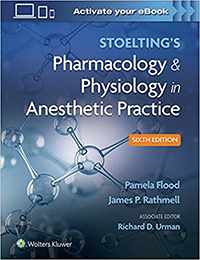
Edition 6 (2021)
Pamela Flood, James Rathmell, Richard Urman
Comprehensive, readable, and clinically oriented, Stoelting’s Pharmacology & Physiology in Anesthetic Practice, Sixth Edition, covers all aspects of pharmacology and physiology that are relevant either directly or indirectly to the anesthetic practice—a challenging topic that is foundational to the practice of anesthesia and essential to master. This systems-based, bestselling text has been thoroughly updated by experts in the field, giving you the detailed information needed to make the most informed clinical decisions about the care of your patients.
Offers trainees and practitioners authoritative content on all aspects of pharmacology and physiology that are relevant to anesthesiology.
Features up-to-date coverage of new drugs, as well as new findings on the actions and interactions of established drugs.
Discusses antimicrobials and chemotherapeutic drugs, as well as special populations such as the newborn, the parturient and fetus, the elderly, and the physiology and pharmacology of resuscitation.

